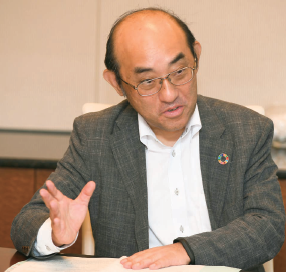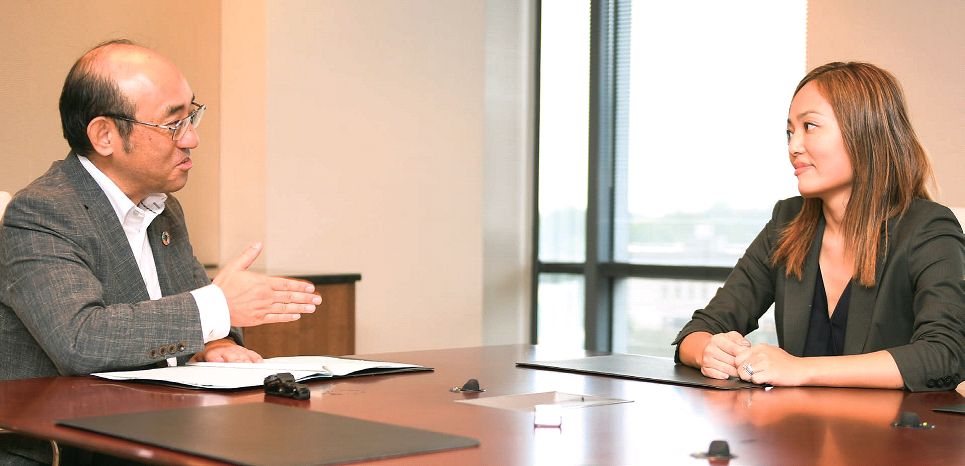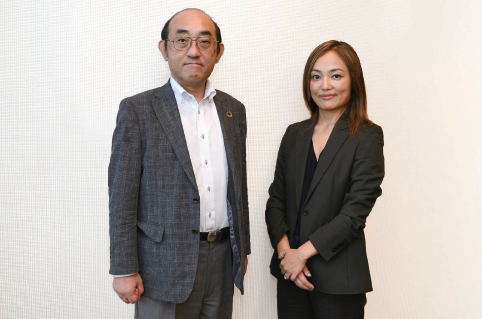Interviews with experts and opinion leaders from our research network
As the extent of damage from natural disasters with a major impact on human lives and social activities increases globally, the importance of establishing an emergency management system and facilitating collaboration among various organizations and institutions is increasing as never before. In this issue, we have invited Dr. Maki Fukami, the President & CEO of the International Institute of Global Resilience (IIGR), to discuss future emergency management. IIGR is a U.S.-based institute aiming to help strengthen the professionalism of the emergency management community through education, research, and consulting.

President & CEO of the International Institute of Global Resilience
Dr. Fukami graduated from the Faculty of Economics at Kyoto University and also received her Ph.D. in Economics from Kyoto University. She was selected as a Japan Society for the Promotion of Science Research Fellow (DC1, PD). She was also a Visiting Scholar of the University of California, Los Angeles (UCLA), and of the George Washington University. She subsequently established the International Institute of Global Resilience (IIGR) in Washington, D.C. Dr. Fukami provides world-class education and training programs to governments, local municipalities, companies, universities, and others while leading joint projects with major U.S. think tanks, including the Center for a New American Security and the Stimson Center. In 2017, she invited Mr. Craig Fugate, the former administrator of the Federal Emergency Management Agency (FEMA), to Japan for the first time in Japan and held an event designed to facilitate interaction between Japanese and U.S. practitioners. At the International Association of Emergency Managers (IAEM), formerly the U.S. Civil Defense Council, she served as the Japan representative, including as the first President of the Japan Council, for seven years, and as a Global Board member for three years.
Shirai:There have been an increasing number of major natural disasters around the world. Recently, we have seen many natural disasters that cause severe damage across extensive areas, such as torrential rain in western Japan, earthquakes occurring across Japan, and a deadly hurricane that hit the southeastern U.S. What do you think of recent natural disasters and the progress of preparedness measures?
Fukami:In the United States, the Federal Emergency Management Agency (FEMA) was established about 40 years ago. Issues related to the increasing complexity and geographical expansion of disasters were already being discussed at the time and there was a common understanding that situations were increasingly changing. Issues concerning changes in types, nature, and frequency of disasters along with the expansion of cases requiring response have been repeatedly highlighted in the United States for the last 40 years. If there seems to be a rapid increase in such discussions in Japan, it means Japan is finally catching up to the United States.
Effective emergency management is important when responding to disasters. The culture and values of a community are reflected in any management, not only in emergency management. As the damage from disasters becomes increasingly extensive and complex around the world, the importance of emergency management is steadily increasing. Each community’s culture and values seem to be reflected in how they manage emergency situations amid such circumstances.
Shirai:Japan is facing difficulties in making a sharp increase in its budget for disaster preparedness and response due partly to fiscal constraints. In addition, fiscal conditions are expected to weaken in the future due to the falling population. As the seriousness of natural disasters increases, which issues should state and local governments prioritize?
Fukami:If organizational roles are clarified in Japan, there are many issues that can be resolved financially and systematically. However, since there is a shortage of individuals who can discuss emergency management, including policies and projects, from professional perspectives, development of emergency management professionals is the top priority in Japan.
Shirai:The probability of a Tokyo inland earthquake and a Nankai megathrust earthquake occurring within 30 years is estimated at 70% and 70-80%, respectively. Economic loss over 20 years from the earthquakes is estimated at 778 trillion yen and 1,410 trillion yen, respectively. Although they are regarded as a national emergency, a lack of urgency has been pointed out.
In July this year, I had an opportunity to talk with University of Chicago Professor Richard Thaler, who won the 2017 Nobel Prize in Economic Sciences, and what he told me stuck out in my mind. Professor Thaler, who is a behavioral economist, highlighted the term “normalcy bias,” which is a term used in behavioral psychology. Normalcy bias means that people try to remain calm, even when they are told, for example, that there is a 90% probability of a Tokyo inland earthquake occurring within 30 years, by thinking that at least it will not happen tomorrow. Despite the fact that an earthquake can happen any day, even tomorrow, people try to go about their daily lives assuring themselves that it is something that will happen in the distant future.
While there are many things that should be prepared and addressed in advance, progress in tangible activities has been slow. What do you think is the cause of the delay?
Fukami:“Simple is best” is the basic rule for emergency management in the United States. All governmental and political organizations have emergency managers and the FEMA administrator,

who is under the direct authority of the president, is their head. The first task of emergency managers is to fully assess risks in their jurisdictions and administrative districts by supporting governors, county executives, and mayors. They allocate necessary resources and implement countermeasures after prioritizing risks by assessing all related data. This includes the situation of past disasters, geographical factors, characteristics of regions and organizations, status of aging and vulnerability of infrastructure and buildings, and demographics. Preparations are made using an all-hazard approach, which is designed to make preparations in order to flexibly respond to any disaster or emergency situation.
The purpose of emergency management is saving human lives under comprehensive management, and thus search and rescue techniques are only one part of it. Meanwhile, there are many other things that need to be done, including infusing public funds and human resources and taking medical preparedness measures. People who are capable of managing the process of integrating and coordinating all efforts being spent for taking response must be in a position to oversee all operations. In that sense, they are also management professionals. It is essential to have persons who are capable of assessing risks and judging priorities of response from the management perspective.
Shirai:What issues does Japan have to address in developing emergency managers?
Fukami:There is no institution that provides professional training on emergency management in Japan. The National Police Agency and Ministry of Land, Infrastructure, Transport and Tourism (MLIT) have official authority for disaster and emergency management. FEMA’s counterpart in Japan is the Cabinet Office (in charge of disaster management), and secondees from MLIT are generally assigned to the position. However, functions of MLIT being in charge of land development and transportation and those of FEMA specializing in disasters, including terrorism and human-made disasters on top of natural disasters, differ widely. Given that emergency managers of the U.S. Department of Transportation receive top-notch education in emergency management, it may be a good idea for MLIT to facilitate the development of emergency managers.
The United States takes a scientific approach, with great importance put on data, to disaster preparedness and responses from the management perspective. Japan, on the other hand, seems to have a culture that does not necessarily facilitate the use of data.
Shirai:In Japan, about 74% of the total population lives in disaster risk areas with the possibility of suffering from major damage from flooding, landslides, earthquakes, liquefaction, or tsunami. It has been pointed out that, with increasing scale of natural disasters, people must raise awareness to protect themselves, without solely relying on the government. It is a harsh reality that the government cannot save people who ignore evacuation orders. How should we change people’s awareness and behavior?
Fukami:The United States has put a strong emphasis on promoting education and awareness of its people since the establishment of FEMA. The government has allocated a large budget for raising public awareness as the government is unable to follow up on everything and, ultimately, public understanding is needed. In emergency management, the extent to which issues are regarded as risks differs according to individuals. Government efforts to actively lead education and guidance rather than leaving it to local municipalities will eventually lead to protecting the lives of its people. Since it is difficult to prompt individuals to think about disaster management on a daily basis, it is effective to raise awareness by assigning professionals such as U.S. emergency managers at each government level. Improvising, or being able to think on your feet is the skill that is most needed for emergency managers. In other words, emergency managers need the ability to imagine how to quickly respond to situations that they have never encountered before and the skills to take a flexible approach, just as musicians do improvising, and provide solutions. Since professionals with these skills are assigned to the federal, state, county, and municipality level, the United States is capable of responding effectively to unexpected cases. It all comes down to developing professionals.
Shirai:Are educational institutions such as universities responsible for developing emergency management professionals in the United States?
Fukami:Universities are involved but FEMA is primarily responsible for developing emergency management professionals. FEMA has unique educational institutions and provides over 500 curricula. The higher education conference is held annually to create curricula where university researchers and practitioners from all over the nation gather and hold discussions. In addition, focus groups fully assess the effectiveness of each curriculum and subject in the field and conduct aptitude test for instructors.
Standard knowledge is shared widely as universities across the nation provide education using FEMA curricula in addition to emergency management education on a national level. While each university gives lessons independently, FEMA’s standardized program is believed to be playing an important role.
Shirai:The guidebook on the Incident Command System (ICS) (Tokyo Hoki Shuppan), which you co-authored, features the 2013 Colorado floods where the ICS functioned effectively and Hurricane Katrina in 2005 where the ICS caused confusion among disasters experienced in the United States. What determined the success or failure of emergency management in these two cases?
Fukami:The ICS, which is a standardized national system for emergency response in the United States, is used widely, ranging from daily incidents and accidents to large-scale disasters and terrorism. All of these are successful examples of an ICS. The ICS is recognized as a best practice in the United States and there are almost no cases of failure.

However, the ICS did not function well for Hurricane Katrina. In responding to Hurricane Katrina, FEMA, which had been under the president's authority until then, was put under the U.S. Department of Homeland Security (DHS), which was established following the 9/11 attacks. This caused ambiguity in power and authority and confusion in the chain of command,
resulting in a decline in response speed and an increase in the degree of damage. The U.S. General Accounting Office investigated the case and concluded it was a failure. FEMA was subsequently put under the president’s authority again. While FEMA remains a part of DHS, the FEMA administrator now declares a state of emergency in emergency situations. People are what drive management.
Shirai:Do you think that damage from the Great East Japan Earthquake on March 11, 2011 could have been reduced if Japan had had a system like the ICS?
Fukami:The situations may have been a little bit different if enough human resources had been secured and developed to shift all related persons. However, there was a shortage of human resources and this caused a situation where many people responded without getting any sleep. Media repeatedly featured then-Chief Cabinet Secretary Yukio Edano, who had red eyes and said that he had not slept for days. It may be a part of Japanese culture and values that even leaders should respond with no sleep in emergency situations. However, a more rational approach, which acknowledges the limits of the human body, should be applied. It is quite natural that leaders cannot make correct decisions when they are exhausted.
Another issue is in communication to distribute risk-related information. In the wake of accidents at the Fukushima Daiichi nuclear power plant, the then-Nuclear and Industrial Safety Agency, Tokyo Electric Power Company, and the government provided conflicting reports. Amid close attention from Japan and around the world, providing inaccurate information or applying wrong communication approaches will result in a loss of credibility. We witnessed confusion in various areas in the media, including inter-organizational communication and press conferences. These areas also need thorough preparation.
Shirai:What was the cause of the communication failure?
Fukami:Communication failed because more than one person disclosed information in an uncoordinated fashion. In an emergency situation, risk-related information must be distributed in a timely, clear, and accurate manner. In order to centralize information distribution, the ICS has set a rule that only one person should stand in front of the media, prohibiting others from talking to the media.
However, taking governmental measures is not enough to save human lives in the field. This was viewed as being extremely problematic at the time of FEMA’s establishment. It reportedly took about 20 years to start providing education for people in the field and exchanging opinions with policymakers. Progress has been made to the extent that the reality which only people in the field are aware of is now reflected in policies. In the past, the selection of FEMA administrator was largely based on political interests. However, Mr. Craig Fugate, who served as the FEMA administrator during the Obama Administration, started his career as a volunteer firefighter in Florida. He has built a career of over 20 years in emergency management and worked in many different fields. The fact that a person who worked his way up the ladder took up the post of FEMA administrator significantly boosted the morale of emergency managers around the nation. President Trump has also appointed a person who started his career in the field as the FEMA administrator.
While all ministries and agencies need to respond in the event of major disasters, the only person who can issue orders is the prime minister in the case of Japan and the president in the case of the United States. It is obviously important for the president to respond to disasters, but the president has many other jobs to do. Even though it is an emergency, the president cannot take command around the clock. What’s more, the president is not an expert in emergency management. Therefore, in the United States, the FEMA administrator, whose authority has been delegated from the president, gives orders to the head of each ministry and agency and quickly implements countermeasures. FEMA is an agency specializing in collecting all relevant information from the field and giving orders on behalf of the president.
Shirai:The geographical scope of damage from natural disasters is expanding globally, and cases to support rescue efforts in other countries are expected to increase in the future. How should we create and develop cross-border mutual support systems in the future?
Fukami:Cross-border collaboration does not function properly unless everyone speaks the same language and understands the same concepts. Given that the United Nations recommends the use of an ICS, the ICS can be considered as a standardized tool. Since many non-native English speakers live in the United States, using plain and simple English is a must for implementing the ICS. If Japanese firefighters can understand the ICS in English and hold a conversation, mutual support will be easier.
Mutual support in the United States means broadening the scope of support. For example, when there is a shortage in local resources, resources are supplied from neighboring towns. If that is not enough, states offer support. The standard approach for the management is the ICS.

Cross-border support has been provided for humanitarian purposes, which requires a mutual support model where advanced nations support each other on an equal footing. The United States has started collaborating with Australia, whose emergency management is advanced, and is making progress toward providing mutual support on a private level.
In addition, the IIGR conducted a collaborative study (U.S.-Japan alliance action plan for all-hazard emergency management) with the Center for a New American Security (CNAS) and concluded that developing human resources who are trained and educated together and have the same knowledge and skills facilitates collaboration. A new support model to provide joint education and training on a regular basis will be created in order to facilitate mutual support between advanced nations.
Active efforts have also been made in Asia, including the establishment of an organization in China which is the Chinese equivalent of FEMA in April 2018 and the invitation of U.S. professionals to the Blue House in South Korea. Japan is also expected to keep up with these trends.
Shirai:In 2018 alone, a large number of typhoons and natural disasters have occurred in and around Japan. Is Japan required to create a system to ensure mutual support with neighboring countries separately from security-related efforts?
Fukami:When the Ministry of the Russian Federation for Civil Defense, Emergencies and Elimination of Consequences of Natural Disasters (EMERCOM), which is the Russian equivalent of FEMA, was established, FEMA and EMERCOM conducted joint exercises. The United States is working effectively by appropriately combining security and disaster management aspects. It is also important for Japan to create disaster management networks with neighboring countries.
Shirai:Turning our attention to the situation in Japan, there seems to be an increasing number of cases where responses are made which go beyond municipal and prefectural boundaries, as seen in the cases of torrential rains hit across Western Honshu and of an earthquake which caused blackouts across Hokkaido. What do you think of the development of networks in Japan?
Fukami:A mutual support system which enables neighboring prefectures and municipalities to collaborate with each other is in place now. Issues of failure to connect hoses due to different standards of fire truck hoses in neighboring towns have been resolved. However, each municipality has authority over disaster management measures, education, and training and there is no standard approach. Since firefighters are dispatched to provide support under such circumstances, it is unclear if the overall operation is carried out effectively. In the United States, the National Fire Academy creates curricula and firefighters across the nation receive training. One of the major missions at the time of FEMA establishment was standardization. It took about 30 years, but operation is said to have been improved considerably, generating tangible results. It is extremely important for Japan to standardize disaster management operation on a national scale.
Shirai:Maybe because disasters have occurred frequently, we may have become a little desensitized to disasters. No matter how serious the damage is, many people are resigned and think “it cannot be helped” because it is a major typhoon, an intensity 7 earthquake, or unexpectable torrential rain.
Fukami:I want everyone to know that “it is not something that cannot be helped.” It is deeply regrettable that many human lives were lost in torrential rains in western Japan despite the fact that the government has invested a lot of money in flood control.
Emergency management in Japan needs to challenge traditional culture and values. We are at a turning point in deciding what needs to be done to save as many lives as possible and reduce economic losses to the greatest extent possible.
Shirai:Business continuity in the event of natural disasters is extremely important for any company. Global companies have established supply chains where the manufacturing process is divided up into different countries and regions. Geographically broad and complex emergency management is needed, for example, paying attention to risks in countries where suppliers and customers are located in addition to countries where theheadquarters and operation bases are located. There is a variety of issues, including how to ensure security of global supply chains and how to develop a system to backup data amid the rapid advancement of IT. Research results indicate that 80% of large companies, 40% of middle market companies, and 20% of small and mid-sized companies have developed or are developing a business continuity plan (BCP). What do you think of Japanese companies’ disaster preparedness and response?
Fukami:I was a board member of the U.S.-based International Association of Emergency Managers, which is a professional association for emergency managers.

While members mainly consist of government officials, people from private sector companies engaging in infrastructure business such as electricity and water are also involved in the association. Emergency managers of Silicon Valley IT companies, including Airbnb and Uber, have started to work with the association in recent years and are exchanging views at an annual conference. However, I rarely see Japanese companies taking such an approach.
I am sure that companies’ risk managers are implementing measures to prepare for disasters in a way that best suits their companies such as global supply chains, repair, and maintenance. In Asia, approaches in Singapore are advanced. I have many opportunities to meet each country’s professionals at emergency management-related meetings. Since I rarely see Japanese people on these occasions, I encourage them to actively participate in these meetings.
Exchanging information overseas makes you aware of various things and gives you inspiration to create new ideas as you look at things from different angles. It is also a great opportunity to find partners who will accommodate resources through networks in a time of emergency. Developing such networks for mutual support will be helpful for companies’ existence.
Shirai:Do you have anything that you expect with regard to disaster preparedness and response using leading-edge technologies such as AI and IoT?
Fukami:I recently worked with a Silicon Valley company that develops an AI-powered disaster simulation. This simulation is extremely precise and able to estimate damage for each house. A simulation being used in Japan estimates damage on per region or area basis. However, when an evacuation order is issued for the entire area, the number of houses that are actually affected in the area is often very limited. Therefore, if damage can be estimated on per house basis, the accuracy of evacuation orders will increase. The simulation has been introduced to San Francisco, Los Angeles, Seattle, and other U.S. West Coast cities. While the simulation is expected to be useful in Japan, it is not feasible at the moment due to the lack of necessary data. If there were a disaster-related database, it would be easier for people to protect themselves. For example, I expect to see in the near future the introduction of services that enable individuals to use an application to easily carry out risk assessment based on multifaceted data such as regional history, geographical characteristics, and economic distribution.
Shirai:In the near future, we may be able to assess risks not only at home but also while traveling, whether for business or pleasure, by obtaining data just like we check the emergency exits in a hotel. There are also many other ideas such as keeping track of location information of field workers using IT.
Fukami:In the United States, emergency operation centers are installed and networked at the county level. The centers function as a task force in case of emergency where representatives from water, gas, school, road traffic, health care, and welfare sectors in addition to fire and police departments get together. Even in ordinary times, the centers operate around the clock and staff members work full-time in order to create a database of disasters, incidents, and accidents regardless of their scale. The centers’ online systems are connected to county, state, and federal networks as well as those of FEMA and Washington, D.C. A system is in place where each officer accesses the database using their mobile devices or computers and shares information. Daily activities such as these are utilized in case of emergency.
Shirai:Thank you for your time.
Fukami:Thank you.

In this issue, we talked to IIGR President & CEO Dr. Fukami, who is an expert in emergency management at a time of disaster and involved in wide ranging activities such as research, education, and consulting, about various topics, including U.S. emergency management approaches, comparison between Japanese and U.S. approaches, and examples of the use of leading-edge technologies. As the seriousness of natural disasters increases in the world, she provided thought-provoking views, including the importance of appropriate staffing and collaboration going beyond country and corporate boundaries as well as the need for developing emergency management professionals. The interview helped me re-acknowledge the importance of emergency management for companies.